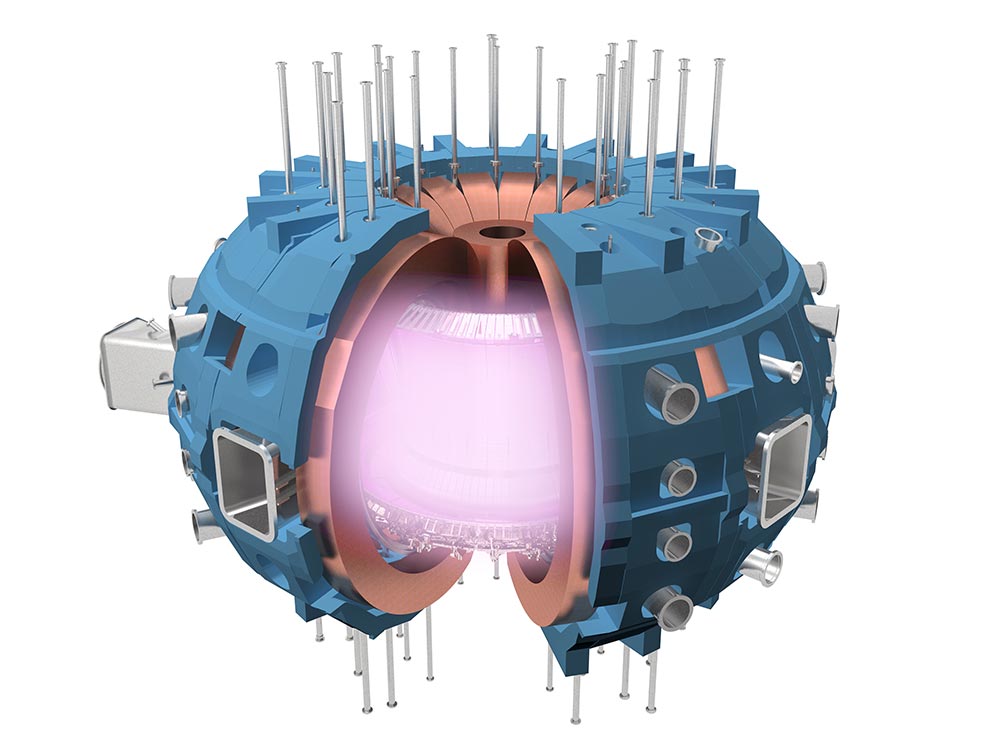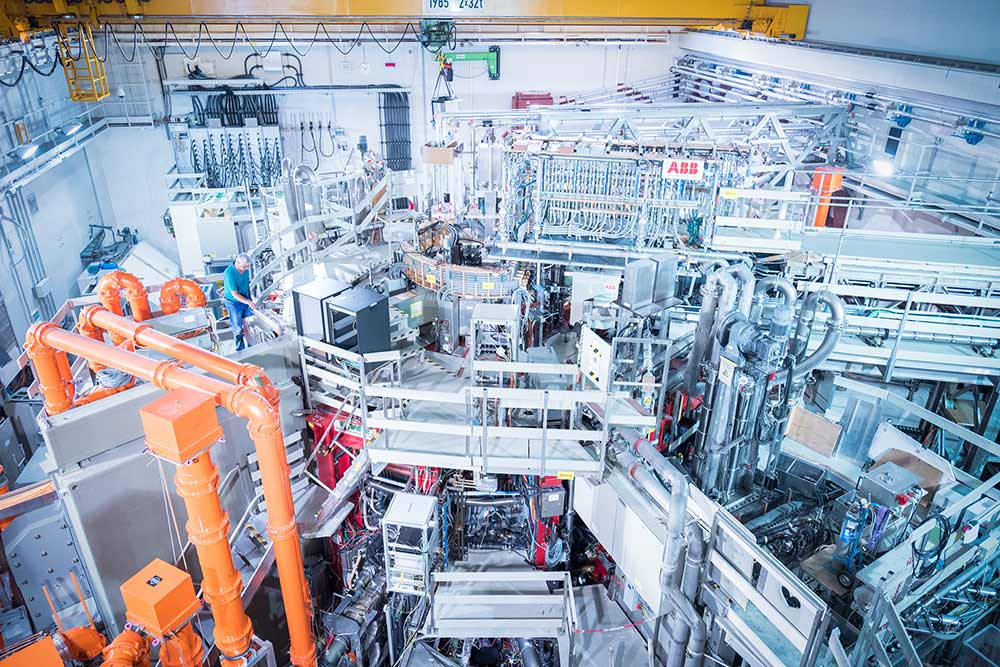i-doit at the Max-Planck-Institute for Plasma Physics
ASDEX Upgrade: Nuclear fusion research made in Europe
The Max Planck Institute for Plasma Physics is considered one of the leading and largest institutions for research into energy production from nuclear fusion. Worldwide outstanding projects like Wendelstein 7-X in Greifswald were developed by the more than 1100 employees.
Another project of the Max Planck Institute is "ASDEX Upgrade" (AxialSymmetric Divertor-EXperiment). Along with Wendelstein 7-X, this facility is one of the largest German test facilities. Since 1991, more than 40,000 plasma ignitions have been performed here. ASDEX Upgrade is used to investigate aspects of plasma physics relevant to the ITER fusion reactor currently under construction and its eventual successor DEMO. The experiments conducted here are intended to answer questions about the future generation of electrical energy from the fusion of atomic nuclei under power plant-like conditions.
The data from this facility are quite impressive. With a diameter of over 16 feet and a weight of 800 metric tons, a fusion plasma is brought to a temperature of 100 million degrees Celsius with a heating capacity of up to 27 megawatts in this facility.
Since the construction of the plant, the power supply and additional heating systems as well as the measurement and control equipment have been continuously expanded. This has resulted in an enormous inventory of equipment and facilities available to scientists. As the number of facilities inevitably increased, so did the complexity. It became increasingly difficult to keep track of the individual devices, their arrangement and dependencies. This led to the decision to introduce a new inventory system. The choice fell on i-doit pro.
What led to the decision for i-doit pro?
Much of the project's data could have been entered in Excel. However, such tables are one thing above all: static. Maintaining the data efficiently and, above all, automatically is only possible with enormous effort.
Another disadvantage: The life cycle of a system, all changes, innovations and updates are difficult to map with Excel. It was therefore clear that a database solution would have to be used to meet the high requirements for documentation and automation.

Organization: Max-Planck-Institut for Plasma Physics
Department: ASDEX Upgrade, Basic Research Plasma Physics
Employees: approx. 1.100
Built: 1991
Number of experiments performed: more than 40.000
Evaluation of suitable solutions
While evaluating different solutions for the inventory, the Max Planck Institute team realized that the problems to be solved were also known in another area: IT. It quickly became clear that a configuration management database would be the appropriate solution. In the course of an evaluation, various CMDB solutions were put through their paces. i-doit pro was able to convince across the board. In the end, the high flexibility, the expandability and the many integrated interfaces were the deciding factors.
These criteria were important for the decision:
- Scalability of database size and number of objects
- Mehrsprachig (Deutsch und Englisch)
- Browser-based and thus largely independent of operating systems or the installation of special software
- Installation on site (on-premise)
- Data is stored on a local server, not in a foreign cloud
- Single sign-on with central employee ID card
- Hierarchical permissions for read, write, access prevent unintentional manipulation of data records
- Data backup and archiving with recording of changes
- Regular updates with new functions, bug fixes and change history, also taking user suggestions into account
- Good and fast support

ASDEX Upgrade fusion facility: plasma, divertor, plasma vessel (with numerous observation ports), main magnetic field coils and their support structure. (Graphic: MPI for Plasma Physics, Mathias Dibon)
Source: https://www.ipp.mpg.de/bilder/asdex

(Photo: MPI for Plasma Physics, Jan Michael Hosan)
Source: https://www.ipp.mpg.de/bilder/asdex
Setup and commissioning of
i-doit pro
For the operation of i-doit, the installation on a dedicated server was chosen. Access control was implemented with single sign-on so that employees could use their usual access data. The granular rights system of i-doit pro made it possible to meet all the requirements of the Max Planck Institute in order to control access to information according to need.
The introduction of i-doit at a research facility like the ASDEX upgrade is not a classic IT project. The IT-oriented concept of i-doit pro had to be adapted, whereby the software was able to prove its flexibility. The main focus here was on the acquisition of diagnostic units, control cabinets, sensors and actuators. For these assets, separate object type classes were defined in advance and created via the WebGUI.
Before i-doit was used productively in the Torus hall, over 100 well-documented devices served as test objects. The data for these devices was available in spreadsheet documents that could be imported as a CSV file in a single operation.
No such documents existed for the diagnostic devices and the Torus Hall installations. The missing data was and is being added manually. To ensure a uniform structure and naming of the objects, only one employee is currently authorized to create new objects. The detailed information on the individual devices, on the other hand, is collected by the "owners" in lists and then imported into i-doit via mass import.
Infrastructure and services coverage
The relationship concept of the i-doit CMDB is also used in the ASDEX upgrade. A diagnostic unit is defined as a location via a local relationship to which the "control cabinet" components and the associated "laser" are linked.In addition to these local relationships, functional dependencies (services) are also mapped, as they are known from the IT environment. Certain services are only available if all the components involved are functioning. In the ASDEX upgrade, the evaluation of video material is a very important service. This service is only available if all components from the camera head to the evaluation processor function smoothly.
A special feature of the functional dependencies is that one component can be used in several services. By using the i-doit CMDB, the responsible employees can now see at a glance which components are affected by the maintenance of a system, for example. They are able to develop preventive and corrective measures.
Requirement for cabling
and acquisition of measurement signals
In addition to the pure recording of the infrastructure, the signal paths are an important criterion in research. In a complex plant like the ASDEX upgrade, hundreds of sensors are used, e.g. temperature, pressure and flow meters. Traceability is essential here.
Information must be available at all times about which sensor is sending its signal to which system or signal transmission room. The signals are isolated, filtered, amplified and then digitized to various recording, control and protection systems.
i-doit pro offers the possibility to document the cabling for each asset. In addition, a distinction is made between inputs and outputs. This allows the entire measurement chain with its cabling to be mapped true to the original.
Even the cables used are uniquely identified by the assignment of a cable number. At the Max Planck Institute, the final destination for the measurement signal (scientific database) is also created as a virtual object. In this way, it is possible to represent where the data is finally stored after processing.
As additional support, the i-doit pro add-on Floorplan is used. On each floor the transformers and other devices are exactly placed to get a quick overview from each floor.

(Photo: MPI for Plasma Physics, Volker Rohde)
Source: https://www.ipp.mpg.de/bilder/asdex
Assignment of responsibilities
With the large number of technical devices, responsibilities must be defined. The existing standard category "Contact assignment" is used for this purpose. This category is used to enter the operators and users on the one hand, and the persons responsible for maintenance and operation on the other. In this case, however, it is not individual users that are linked as contacts, but groups.This solution offers a decisive advantage. In the event of a change of personnel, the administrative effort is reduced. Users are simply removed from the respective group. The new employee is added. The groups and their assignments, on the other hand, do not need to be changed.
In day-to-day operations at the ASDEX upgrade, each group decides for itself how extensively it documents information about components. The principle here is that the more relevant information is available, the easier it will be to analyze the causes of any problems that arise. This, in turn, is in the interest of the groups.
A positive side effect: When the systems in the Torus hall were recorded, it was found that the responsibility for around 350 items was not clear. For these objects, it is now possible to identify contact persons and clarify further use. In this way, the introduction of i-doit contributes to greater transparency.
The future of i-doit in the ASDEX upgrade project
After the successful rollout of the CMDB i-doit, essential information about the existing systems is available centrally. The CMDB gives all employees uniform access to the parameters and status of systems. Links, maintenance intervals and responsible contact persons are visible at a glance, as are overview diagrams and plant images.In fact, i-doit was initially intended only for documenting the electrical components in the Torus hall. However, the system has since been expanded to include all transformers at the Garching site. Furthermore, i-doit records all irradiated components leaving the Torus Hall. This supports conformity with existing radiation protection requirements.
The biggest challenge in the future will be the continuous maintenance of the created objects. Missing and new components have to be created and new services have to be implemented. However, this challenge is also the greatest opportunity. The introduction of the new CMDB offers a unique opportunity to clarify the status, responsibility and further use of previously unresolved objects.
Overall, the Max Planck Institute rates i-doit as a very useful tool for capturing assets, documenting cabling and ports, and mapping their services.

